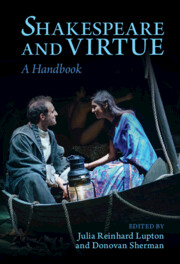Book contents
- Shakespeare and Virtue
- Shakespeare and Virtue
- Copyright page
- Contents
- Contributors
- Acknowledgements
- Introduction
- Part I Shakespeare and Virtue Ethics
- Chapter 1 Aretē (Excellence, Virtue)
- Chapter 2 Dynamis (Dynamism, Capacity) and Energeia (Actuality)
- Chapter 3 Technē (Technical Expertise, Skill)
- Chapter 4 Eudaimonia (Happiness)
- Chapter 5 Ethos
- Chapter 6 Hexis (Habit)
- Chapter 7 Stoicism
- Chapter 8 Skepticism
- Chapter 9 Askesis and Asceticism
- Chapter 10 Shakespeare’s Moral Compass
- Part II Shakespeare’s Virtues
- Part III Shakespeare and Global Virtue Traditions
- Part IV Virtuous Performances
- Works Cited
- Index
Chapter 9 - Askesis and Asceticism
from Part I - Shakespeare and Virtue Ethics
Published online by Cambridge University Press: 19 January 2023
- Shakespeare and Virtue
- Shakespeare and Virtue
- Copyright page
- Contents
- Contributors
- Acknowledgements
- Introduction
- Part I Shakespeare and Virtue Ethics
- Chapter 1 Aretē (Excellence, Virtue)
- Chapter 2 Dynamis (Dynamism, Capacity) and Energeia (Actuality)
- Chapter 3 Technē (Technical Expertise, Skill)
- Chapter 4 Eudaimonia (Happiness)
- Chapter 5 Ethos
- Chapter 6 Hexis (Habit)
- Chapter 7 Stoicism
- Chapter 8 Skepticism
- Chapter 9 Askesis and Asceticism
- Chapter 10 Shakespeare’s Moral Compass
- Part II Shakespeare’s Virtues
- Part III Shakespeare and Global Virtue Traditions
- Part IV Virtuous Performances
- Works Cited
- Index
Summary
This chapter traces the dual legacy of Christian asceticism as an art of living with distinct but related rules for virtue in monastic and married life. The forms of ascetic virtue cultivated in the early Church have a significant afterlife in sixteenth century fiction and drama, exemplified in Thomas More’s Utopia (1516) and Shakespeare’s The Winter’s Tale (1610). In Utopia, married couples are essential citizens of an ascetic commonwealth, but also potentially at odds with its communal quasi-monastic virtues. The Winter’s Tale reveals a fault line in marriage as an ascetic mode of life: the tension between marriage as a legal code and marriage as a sacrament and relationship of fidelity can only be resolved by turning to the more radical asceticism of penance. These works demonstrate how ascetic practices mediate between self and society; they reflect on ways to cultivate a virtuous life that extend beyond the household or the cloister to the wider world of public and political action.
Keywords
- Type
- Chapter
- Information
- Shakespeare and VirtueA Handbook, pp. 88 - 97Publisher: Cambridge University PressPrint publication year: 2023

